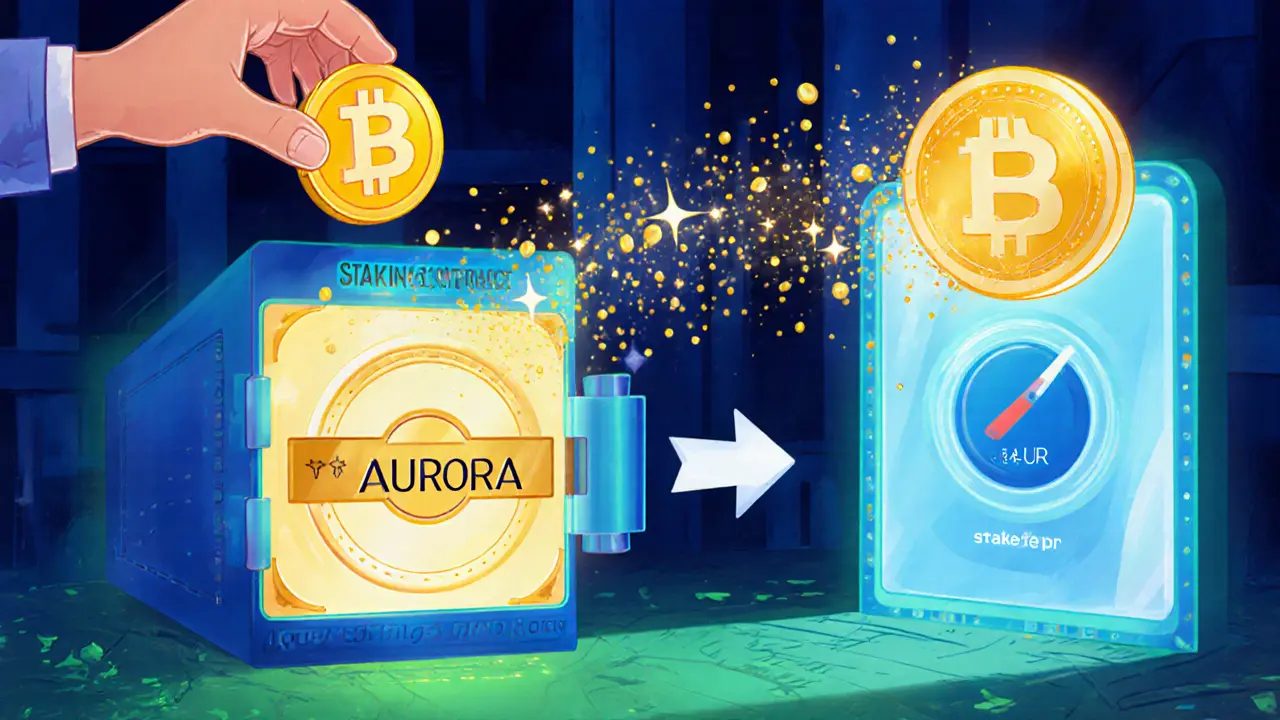MPDAO Liquid Staking Calculator
Current MPDAO Metrics
Price: $0.03155288
24h Volume: $6,600
All-Time High: $0.118024
Market Cap: ~$31 million
Staking Parameters
APR: 8.5% (estimated)
Unbonding Period: 7 days (standard)
Fast Unstake Fee: 0.5%
Supported Chain: Aurora (NEAR EVM)
Estimated Earnings Comparison
Traditional Staking:
- Earned: $0.00
- Lockup: 7 days
- Liquidity: Locked
MPDAO Liquid Staking:
- Earned: $0.00
- Lockup: Instant (with fee)
- Liquidity: Active
The Meta Pool DAO (ticker MPDAO) is a crypto project that aims to combine staking rewards with instant liquidity. If you’ve ever wanted to earn yield on your tokens without locking them away for weeks, MPDAO might be the answer.
Quick Overview
- MPDAO is a liquid‑staking protocol that issues Liquid Staking Tokens (LSTs).
- It launched on the Aurora Protocol, the first native LST provider for that chain.
- Tokens represent staked assets plus accrued rewards, so you keep liquidity while earning.
- Multi‑chain expansion includes the Internet Computer Protocol (ICP) and future EVM‑compatible networks.
- Current price (Sept302025) is around $0.0315 with a market cap near $31million.
What Is Meta Pool DAO?
When people talk about Meta Pool DAO (ticker MPDAO), they are referring to a blockchain infrastructure project that provides a "liquid staking" service. In plain terms, you deposit a supported token, the protocol stakes it on your behalf, and you receive a corresponding Liquid Staking Token (LST) that tracks both the original amount and any rewards earned.
This model solves a classic DeFi pain point: traditional staking locks your assets for a fixed unbonding period, making it impossible to move or trade them until the lock expires. MPDAO’s LSTs stay in your wallet, can be swapped, used as collateral, or even integrated into other DeFi apps, all while still earning the underlying staking yield.
How MPDAO Works - The Staking Flow
The process can be broken down into four simple steps:
- Deposit: Send a supported token (currently stAUR on Aurora) to the MPDAO smart contract.
- Mint LST: The contract issues an equivalent amount of Liquid Staking Token (LST)-for Aurora, this is stAUR.
- Accrue Rewards: While the underlying tokens are staked on the Aurora network, they earn block‑level rewards automatically. The LST balance updates proportionally, so your holdings grow without any extra action.
- Redeem: If you need immediate cash, you can burn your LST for the underlying token plus earned rewards. An optional “fast‑unstake” fee gives you instant access; otherwise, a standard unbonding period applies.
This flow keeps capital efficient-your tokens stay productive, and you retain the freedom to move them around the broader DeFi ecosystem.
Token Economics and Supply Details
MPDAO has a hard cap of 1billion tokens, with 999,999,900 units listed on most explorers. The circulating supply isn’t publicly disclosed on major aggregators, which means market‑cap figures are approximations based on the last known supply data.
Key economic metrics as of the end of September2025:
- Price: $0.03155288 (24‑hour range $0.02715526‑$0.03216012)
- All‑time high: $0.118024 (April2022)
- All‑time low: $0.00078883 (Nov2023)
- 24‑hour volume: $6,600 with a massive +1032% spike, indicating renewed trading interest.
Because the token’s utility is tied to the liquid‑staking service, price movements often reflect protocol usage, network upgrades, and broader sentiment toward Aurora and ICP ecosystems.
Why Aurora Protocol Matters
Aurora is an EVM‑compatible blockchain built on top of the NEAR Protocol. It leverages NEAR’s sharding for high throughput and low latency, while offering full compatibility with Ethereum tooling. This means developers can deploy Solidity contracts on Aurora without major changes.
MPDAO’s first LST, stAUR, is the inaugural native liquid‑staking token for Aurora. The synergy is two‑fold:
- Stakers gain yield on Aurora’s native token without sacrificing liquidity.
- DeFi apps on Aurora can accept stAUR as collateral, boosting composability across the ecosystem.
Because Aurora uses the Rainbow Bridge to move assets between Ethereum and Aurora, MPDAO can attract users who already hold ETH‑based assets and want to explore Aurora’s low‑fee environment.

Multi‑Chain Ambitions: Internet Computer Protocol
In September2024, MPDAO announced a deployment on the Internet Computer Protocol (ICP). This move signals a broader strategy: be the go‑to liquid‑staking layer across emerging chains, not just Aurora.
ICP offers a different set of incentives-its canister model and high scalability make it attractive for large‑scale DeFi apps. By providing LSTs on both Aurora and ICP, MPDAO can capture yield‑seeking capital from two distinct user bases, while also positioning itself as a bridge for cross‑chain liquidity.
Comparing MPDAO to Traditional Staking
| Feature | Meta Pool DAO (MPDAO) | Traditional Staking |
|---|---|---|
| Liquidity | Immediate via LST (e.g., stAUR) | Locked until unbonding period ends |
| Reward Accrual | Auto‑compounding; reflected in LST balance | Rewards paid out periodically, no automatic compounding |
| Unbonding Time | Fast‑unstake option (fee‑based) or standard period | Fixed unbonding (often 7‑21 days) |
| Cross‑Chain Use | LST can be used as collateral, swapped, or bridged | Typically confined to the original chain |
| Governance | DAO‑driven; MPDAO holders can vote on upgrades | Usually no direct governance for stakers |
Risks and Things to Watch
While liquid staking sounds like a win‑win, there are a few risk factors to keep in mind:
- Smart‑contract risk: The MPDAO contracts manage both the underlying stake and the LST minting process. A bug could affect funds.
- Protocol risk: If Aurora or ICP experiences a major outage, LST values could temporarily drop.
- Liquidity risk: Though LSTs are tradable, the market depth is relatively low (24‑hour volume around $6.6K). Large sell orders could impact price.
- Regulatory risk: Some jurisdictions may treat LSTs as securities, introducing compliance challenges.
Smart investors usually diversify across multiple staking solutions and keep a portion of assets in fully liquid, non‑staking wallets.
How to Get Started with MPDAO
- Set up an Aurora‑compatible wallet (e.g., MetaMask pointed at the Aurora RPC).
- Acquire AURORA tokens on a major exchange and bridge them to Aurora via the Rainbow Bridge.
- Visit the official MPDAO web app, connect your wallet, and choose the amount of AURORA you want to stake.
- Confirm the transaction. The contract will mint an equal amount of stAUR LSTs to your address.
- Use your stAUR-trade it, supply it to lending platforms, or keep it as a yield‑generating asset.
- To unstake, either opt for the fast‑unstake (pay the small fee) or wait for the standard unbonding period, then burn your stAUR for the underlying AURORA plus rewards.
The same steps apply on the ICP network, except you would use ICP‑specific tokens and the corresponding MPDAO bridge.
Future Outlook and Community Governance
MPDAO’s roadmap points to three main priorities:
- Expand LST support to additional chains, potentially including Polygon, Binance Smart Chain, and other EVM‑compatible networks.
- Enhance DAO tools so MPDAO holders can propose and vote on fee structures, new asset listings, and roadmap items.
- Integrate with DeFi primitives like yield aggregators and synthetic asset platforms, increasing the utility of LSTs.
Because the project’s governance is DAO‑based, token holders have a direct say in these developments. However, details about voting thresholds and quorum are still emerging, so staying active in community channels (Telegram, Discord, and governance forums) is essential for anyone looking to influence the protocol’s direction.
Bottom Line
If you need a way to keep your crypto working while still being able to move it around, MPDAO offers a practical solution. The combination of Aurora’s fast, cheap transactions, the ability to earn staking rewards, and the flexibility of Liquid Staking Tokens makes it a compelling addition to a diversified DeFi strategy. As always, weigh the smart‑contract and market risks, and only allocate what you can afford to lose.

Frequently Asked Questions
What does MPDAO stand for?
MPDAO is short for Meta Pool Decentralized Autonomous Organization, the governance body behind the MPDAO protocol.
How is a Liquid Staking Token different from a regular token?
A Liquid Staking Token (LST) represents a staked asset plus any automatically accrued rewards. You can trade, lend, or use the LST in other DeFi apps while the underlying asset stays locked in a staking contract.
Can I unstake my tokens instantly?
Yes, MPDAO offers a fast‑unstake option that burns your LST and returns the underlying token plus rewards immediately, but it charges a small fee. The standard unbonding period is longer but fee‑free.
Which blockchains does MPDAO support?
Initially launched on Aurora (NEAR’s EVM layer), MPDAO expanded to the Internet Computer Protocol in 2024 and plans to add more EVM‑compatible chains such as Polygon and Binance Smart Chain.
How can I participate in MPDAO governance?
Holding MPDAO tokens gives you voting rights in the DAO. Proposals are posted on the official governance forum, and votes are cast through the MPDAO web interface or compatible wallet extensions.


MARLIN RIVERA
September 16, 2025 AT 12:42MPDAO’s APR is a gimmick that masks terrible tokenomics.
Debby Haime
September 16, 2025 AT 13:15Hey folks, love the deep dive into liquid staking! The ability to keep your AURORA liquid while earning yield is a game‑changer. It lowers the barrier for smaller holders who can’t lock up assets for weeks. Keep the analysis coming, it’s super useful.
emmanuel omari
September 16, 2025 AT 13:48Let’s get one thing straight: liquid staking isn’t some new miracle, it’s just a repackaging of existing mechanisms. MPDAO simply takes the standard Aurora staking model and adds a thin wrapper for instant liquidity. The APR of 8.5% is within the range of conventional staking on similar networks, so don’t overhype it. Remember, the fast‑unstake fee of 0.5% will chew into any marginal gains you expect.
Andy Cox
September 16, 2025 AT 14:13yeah i see the point but the instant liquidity feels nice it’s like having your cake and eating it too
Courtney Winq-Microblading
September 16, 2025 AT 14:38When we contemplate the philosophical underpinnings of liquidity, we confront the paradox of freedom versus commitment. MPDAO offers a fleeting freedom that still respects the discipline of staking. It reminds us that capital efficiency isn’t merely a metric; it’s a deep‑seated desire for agency. The trade‑off of a modest fee feels like a modest tribute to the custodians of the network.
katie littlewood
September 16, 2025 AT 15:28Alright, let’s unpack this step by step. First, the concept of liquid staking itself is a response to the age‑old problem of capital lockup, which has plagued validators and delegators alike. Second, MPDAO positions itself within the Aurora ecosystem, leveraging the NEAR EVM compatibility to attract developers who are already familiar with Solidity. Third, the advertised APR of 8.5% may appear modest compared to some high‑risk yield farms, but it offers a much lower volatility profile. Fourth, the unbonding period of seven days aligns with the standard network parameters, meaning you’re not sacrificing security for liquidity. Fifth, the fast‑unstake fee of just half a percent is a reasonable cost for instant access to your assets, especially when you consider the alternative of waiting a full week. Sixth, the tokenomics of MPDAO, with a market cap hovering around $31 million, suggests there’s still room for growth without being overly speculative. Seventh, the liquidity provision through the MPDAO token itself creates a secondary market, allowing users to trade their staked positions without waiting. Eighth, the calculator embedded in the UI is a handy tool for visual learners who want to see potential earnings at a glance. Ninth, the comparison chart clearly delineates the benefits over traditional staking, emphasizing active liquidity as the key differentiator. Tenth, community governance mechanisms are hinted at but not fully fleshed out, which could be an area for future development. Eleventh, the overall user experience feels polished, with clean UI elements and responsive design. Twelfth, security audits are mentioned briefly, but deeper scrutiny would reassure risk‑averse participants. Thirteenth, the inclusion of a fast‑unstake option signals an understanding of market dynamics where users may need to exit quickly. Fourteenth, the platform’s future roadmap includes cross‑chain interoperability, which could widen its appeal dramatically. Finally, for anyone weighing the pros and cons, MPDAO offers a balanced blend of yield, flexibility, and accessibility that makes it worth a closer look.
Jenae Lawler
September 16, 2025 AT 15:53While the exposition is thorough, one must remain skeptical of the purported "balance"; the underlying token distribution remains opaque, and the reliance on a solitary bridge could engender systemic risk. Moreover, the elevated formality of the presentation belies the inherent volatility of liquid staking derivatives.
Chad Fraser
September 16, 2025 AT 16:27Great breakdown, everyone! If you’re new to this, just start small, test the fast‑unstake, and watch how the liquidity feels. You’ll get the hang of it faster than you think.
Jayne McCann
September 16, 2025 AT 16:52It’s just another token pump, nothing special.
Richard Herman
September 16, 2025 AT 17:17Let’s keep the conversation constructive. Even if the token has hype, the liquidity feature does solve a genuine pain point for many stakers.
Parker Dixon
September 16, 2025 AT 17:42Exactly! The ability to withdraw instantly can be a lifesaver during market dips 😊. Just remember the 0.5% fee – it’s minor, but it adds up over many swaps. Keep experimenting and share your results! 🚀
Stefano Benny
September 16, 2025 AT 18:15From a technical standpoint, MPDAO leverages a hybrid LST model that underwrites its peg via a smart‑contract‑backed liquidity pool. The tokenomics, however, suffer from a scarcity‑induced price pressure that could trigger flash‑loan exploits. 🤔 Nonetheless, the integration with Aurora’s EVM layer is a noteworthy architectural decision.
Bobby Ferew
September 16, 2025 AT 18:40Honestly, these numbers feel too good to be true, and the whole thing reeks of over‑promising. The fee structure might be “minor,” but it’s a hidden cost that will chip away at returns.
celester Johnson
September 16, 2025 AT 19:05One could argue that MPDAO exemplifies the modern paradox of decentralization: promising autonomy while subtly centralizing risk. The philosophical implication is that true freedom may be an illusion within tokenized finance.
Prince Chaudhary
September 16, 2025 AT 19:38Appreciate the balanced insights, everyone. It’s encouraging to see a community that can critique constructively while still recognizing potential.
John Kinh
September 16, 2025 AT 20:03Looks okay, I guess.
Mark Camden
September 16, 2025 AT 20:28We must not overlook the moral responsibility inherent in promoting financial products. When a platform like MPDAO advertises “instant liquidity,” it implicitly encourages short‑term speculation, which can be detrimental to the broader ecosystem’s stability.
Evie View
September 16, 2025 AT 21:02Enough of the sugar‑coated fluff-MPDAO is just a distraction from the real issues plaguing the ecosystem, and it’s being sold to the unsuspecting masses.
Sidharth Praveen
September 16, 2025 AT 21:27Stay curious and keep testing the tools. The more data we gather, the better we can all decide if MPDAO truly adds value.